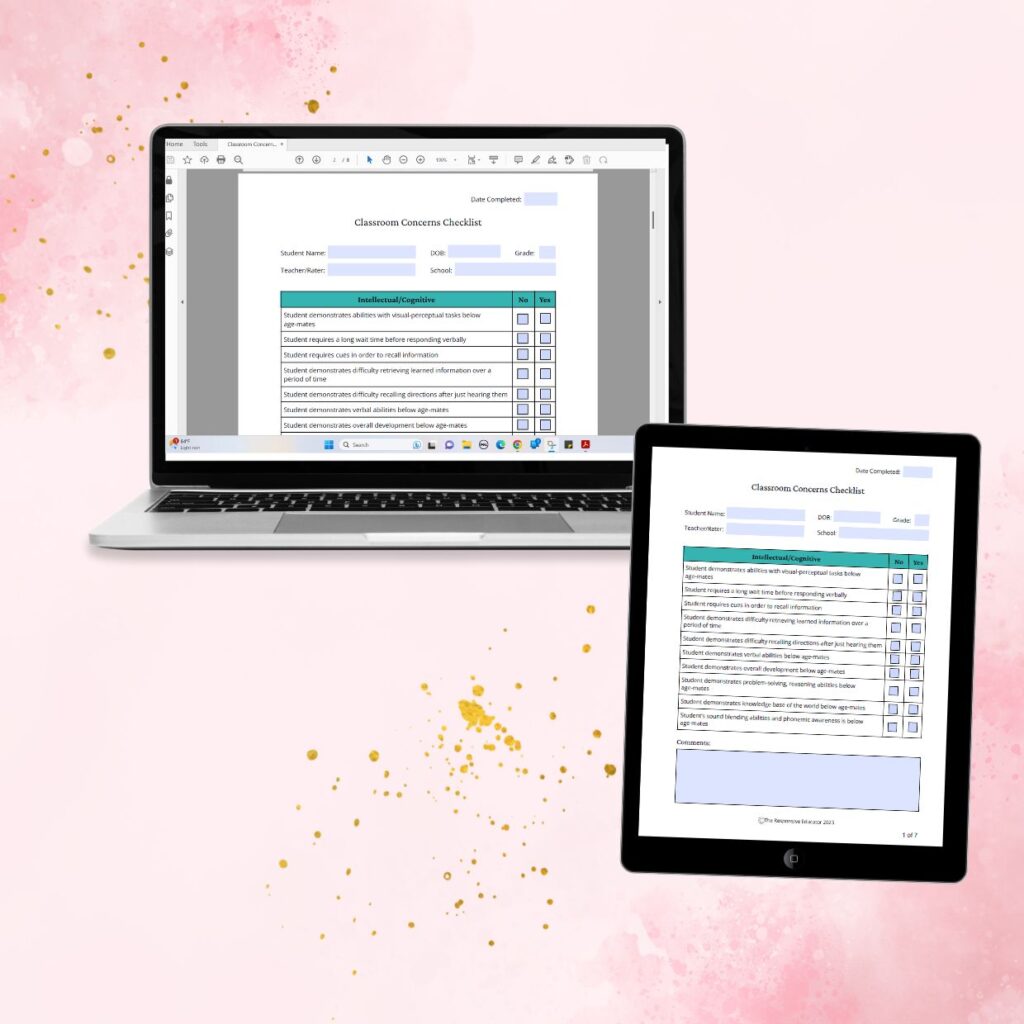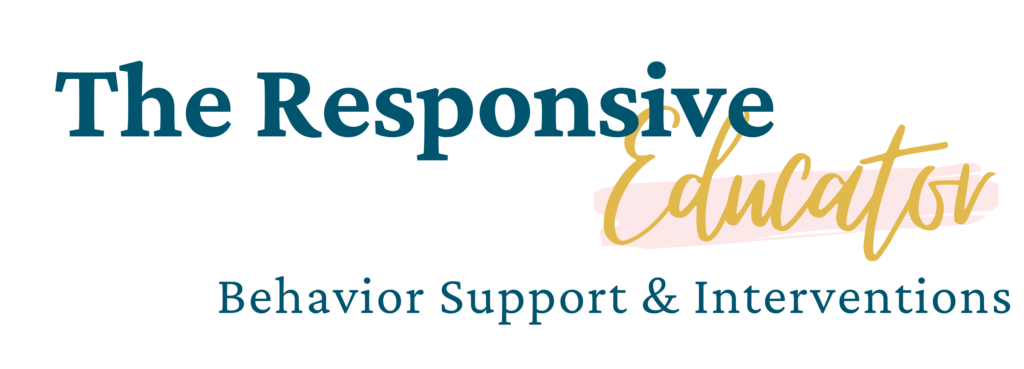
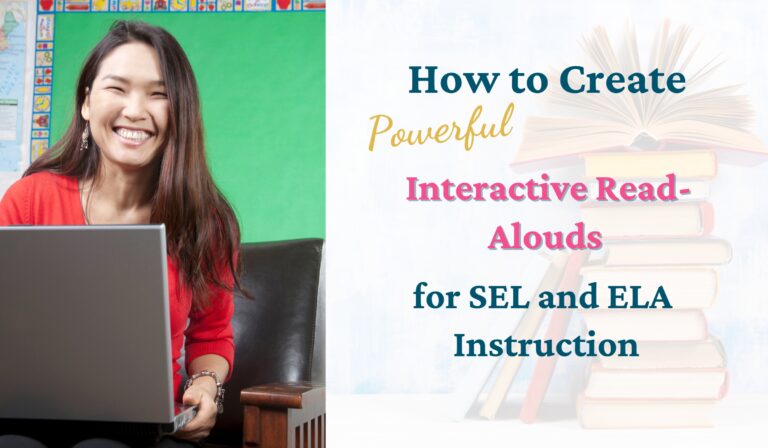
As an elementary school teacher, one of the most impactful and rewarding activities you can use to engage your students is an interactive read-aloud. Not only do interactive read alouds promote a love for literature, but they also offer a unique opportunity to integrate important social-emotional learning and language arts skills. However, to create a truly powerful read-aloud experience, it’s important to be intentional about your selection of books, learning objectives, and extension activities.
In this blog post, we’ll explore the steps needed to plan and execute an interactive read-aloud that addresses both SEL and ELA skills. We’ll follow the journey of elementary teacher Mrs. Ball as she creates an interactive read aloud lesson plan using the book The Invisible Boy by Tracy Ludwig. Through this process, we’ll learn how to select a book, determine learning objectives, and create extension activities that deepen students’ understanding and engagement with the text.
Note: I am an Amazon Affiliate. If you purchase products through the links provided, I will earn a small commission at no extra cost to you, which helps support the blog.
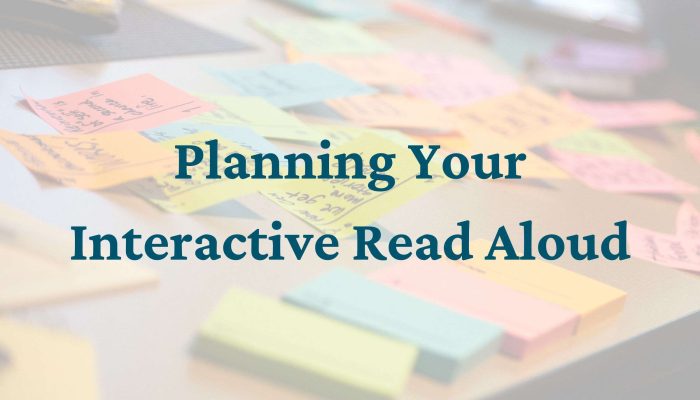
When choosing books for interactive read alouds, start by considering the social-emotional skills you want to address with your students. This could be things like accepting the answer no, asking permission before doing things, or learning from mistakes. There are numerous great options for children’s read aloud books, so you can definitely find one that will work for you. Look for picture books that explicitly address the targeted social-emotional skill, using resources like online book reviews or recommendations from other educators.
Addressing social-emotional learning through interactive readalouds of picture books is a great way to start the conversation in your classroom. The benefits of this type of lesson include promoting empathy and understanding, developing self-awareness, encouraging reflection and discussion, improving communication skills, and building social skills.
If you would like to learn more about the benefits of using interactive readalouds to address SEL skills, as well as take a look at some classroom examples, you can find what you are looking for here.

Mrs. Bell is a passionate and dedicated teacher 2nd-grade teacher who is committed to fostering a supportive classroom environment that prioritizes social-emotional learning (SEL) and equips her students with skills that will benefit them throughout their lives.
After reading The Invisible Boy by Trudy Ludwig, she was struck by the way the book addresses important SEL themes such as empathy, kindness, and inclusion in a way that is accessible and relatable for her students. She believes that teaching these skills is crucial for her students’ development, as they need to learn how to connect with others and build positive relationships both in and out of the classroom.
Mrs. Bell sees The Invisible Boy as a valuable tool for helping her students develop the SEL competencies they need to succeed in school and beyond. She is excited to use the book as a launching point for meaningful discussions and activities in her classroom. She decides to add this book to her repertoire of interactive read alouds.
As you begin your interactive read aloud lesson plan, consider what skills you want your students to develop, and how those skills tie in with the CASEL 5 Competencies. (If you want to learn more about the competencies, see this post and/or the CASEL website.) Here is a brief explanation of each CASEL component and examples of learning objectives related to each one. Please be aware that the examples are just that, and could be worded differently to suit your purposes.
Self-awareness refers to the ability to recognize and understand one’s own emotions and how they impact thoughts and behaviors. This includes being able to accurately assess one’s strengths and limitations, as well as being aware of one’s own values and beliefs.

Self-regulation (also known as self-management) refers to the ability to manage and control one’s own emotions, thoughts, and behaviors in order to achieve one’s goals and maintain a sense of well-being. Self-regulation of emotion includes the ability to manage stress and impulses, as well as being able to set and work towards personal goals.

Social awareness refers to the ability to understand and empathize with the emotions and perspectives of others. This includes being able to take the perspective of others and understand their emotional states, as well as being able to recognize and respond to the emotional needs of others.

Relationship skills refer to the ability to develop and maintain positive relationships with others. Relationship skill building improves a person’s ability to communicate effectively, listen actively, and cooperate with others, as well as the ability to resolve conflicts and negotiate effectively.

Responsible decision-making refers to the ability to make thoughtful and ethical decisions that consider the potential consequences for oneself and others. This includes being able to evaluate different options and make choices that align with one’s own values and the needs of the situation.

As Mrs. Bell begins to plan her interactive read aloud lesson plan, she considers the SEL learning objectives she wants her students to achieve. She thinks about the CASEL 5 Competencies and how they relate to the book. She identifies several objectives for each competency, such as identifying emotions, managing stress, showing empathy, and making responsible decisions.
It’s important to note that Mrs. Bell is brainstorming at this point and does not plan to cover all of these objectives in a single lesson. Due to time constraints, it would be unrealistic to expect her to do so.
Mrs. Bell sits down to brainstorm potential SEL learning objectives for her interactive read aloud of The Invisible Boy. Here is the result of her brainstorming.

Again, remember that these are all potential topics that would fit and book and could be covered. Covering all of these, at least without ample time, would not be feasible.
As you read through your chosen book and develop your interactive read aloud lesson plan, consider what ELA skills fit into the structure and content of the story. For just about any book, you can ask students to identify key details in the story, summarize the plot, analyze the characters’ actions and motivations, and make predictions about what will happen next.
Additionally, some books easily lend themselves to activities around skills like comparing and contrasting, figurative language, or making inferences. It just depends on the book you choose and which applicable ELA skills you decide to address.
By assigning these types of skills based on a read-aloud book, you help your students to not only strengthen their reading comprehension skills, but also encourage them to think critically and empathetically about the characters’ emotions and perspectives, which aligns with the SEL competencies.

After compiling a comprehensive list of potential SEL skills to include in the interactive read-aloud about The Invisible Boy, Mrs. Bell turns her attention to considering ELA skills to incorporate.
Recognizing the synergy between ELA and SEL, Mrs. Bell plans to seamlessly weave ELA skills into her SEL learning objectives without diluting the SEL focus. She aims to provide her students with opportunities to hone effective communication skills through peer discussions and engaging collaborative activities, such as crafting character maps and retelling the story.
By skillfully integrating ELA skills with SEL objectives in her interactive read-alouds, Mrs. Bell crafts well-rounded and impactful learning experiences for her students.
Mrs. Bell takes a moment to brainstorm potential ELA learning objectives for The Invisible Boy. Here’s what she came up with.
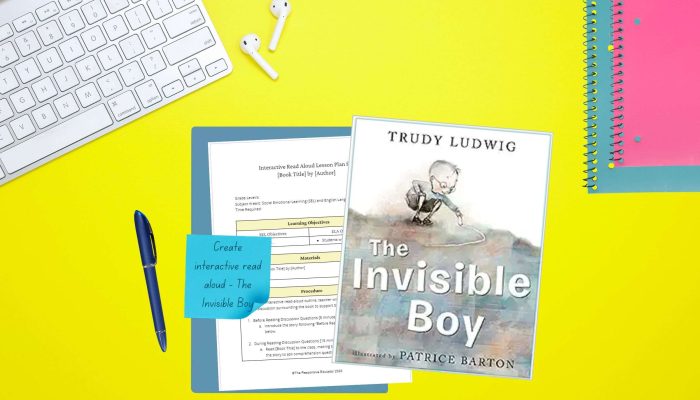
Are you ready to dive into an interactive read aloud with your students? Before you start, take a little time to prepare a list of questions that will guide your students’ understanding of the story. Preparing these questions ahead of time helps you facilitate meaningful discussions and helps students grasp the key elements of the story!
Grab a piece of paper or some sticky notes and go through the book carefully, noting questions you want to ask page by page. Consider both social-emotional learning (SEL) and English Language Arts (ELA) questions to ensure a well-rounded discussion.
To help guide your outline, think about introducing the book and its themes, having students make predictions based on text and images, and activating and/or building on their background knowledge. You also want to set the purpose for the interactive read-aloud, so your students can see the value in what they’re about to read.
Here are some sample questions and things to consider for each section:
When introducing a new book to elementary students, it’s important to start with a captivating and thoughtful introduction. Begin by sharing the title and the names of the author and illustrator. Then, ask if they’re familiar with the author and if they’ve read any of their other books. This can help students make connections to previous reading experiences without overwhelming them with excitement.
To keep your students engaged and curious, ask them to share their thoughts on what they think the title means. This can spark their imagination and get them thinking about the story that’s about to unfold. You’ll be amazed at the creative and insightful responses your students come up with!
By taking the time to introduce a new book in a thoughtful and engaging way, you can capture your students’ attention and prepare them for the reading and discussion to come in a calm and focused manner.

In the “Making Predictions” section of an interactive read-aloud, students are encouraged to use clues from the book’s title, cover, and any introductory information to predict what might happen in the story. This helps to actively engage students in the reading and strengthens their critical thinking abilities.
As the teacher, you can prompt students to share their predictions and support them in explaining their reasoning. You can also encourage them to consider the main character’s personality and any potential conflicts that may arise. This activity not only builds anticipation and interest in the story but also helps students make informed predictions based on textual evidence.
Incorporating this section into your interactive readalouds can be a great way to keep students engaged and excited about reading while also developing their analytical skills.

During an interactive read-aloud, the “Activating and Building Background Knowledge” section plays a crucial role in setting the stage for the story. This involves guiding students to connect their prior knowledge to the book’s theme, characters, and setting. Teachers can ask students if they have any relevant experiences or if they’ve read similar books to create a sense of familiarity.
Providing context related to the story’s setting, time period, or cultural elements can also deepen student understanding and create meaningful connections. By building background knowledge, students can fully engage with the story and make relevant predictions.
Another important aspect of the “Activating and Building Background Knowledge” section is previewing key vocabulary and concepts. Teachers can identify important words or concepts from the story and provide a brief explanation to help students understand their meaning before reading. This can increase student comprehension and make it easier for them to follow the story. Additionally, previewing key vocabulary and concepts can support language development and promote literacy skills.

When starting an interactive read aloud, it’s important to “Set the Purpose” and help students understand why they’re reading this book and how it connects to their learning. Think of it as a compass that guides students through the reading journey ahead!
To get students thinking, teachers can ask some thought-provoking questions like, “Why do you think we’re reading this book today?” or “What do you think we might learn from reading this book?” This helps students focus their attention on the text and understand its relevance to their lives.
But it doesn’t stop there! Teachers can also encourage students to reflect on how they can apply the book’s lessons to their own lives or classroom. Whether it’s a new skill, a fresh perspective, or a life lesson, students will be able to see the value in the reading and feel more engaged in the activity.
By “Setting the Purpose” at the beginning of an interactive read aloud, teachers can help students feel more invested in the reading experience and see how it connects to their lives.

During an interactive read-aloud, teachers have a golden opportunity to help students develop both social-emotional learning (SEL) and English Language Arts (ELA) skills. This “During Reading” section of the read-aloud involves reading the story aloud and actively engaging students in discussion as the story progresses.
As the teacher reads the story, they should bring the characters and their emotions to life with expressive and engaging tones. It’s important to pause at strategic moments and ask questions that encourage students to make predictions and dive deeper into the story.
To promote SEL, the teacher should help students connect with the characters by exploring their emotions and motivations. By asking students to put themselves in the shoes of the characters and imagine how they would feel in similar situations, the teacher can help build empathy and understanding.

To enhance ELA skills, the teacher should encourage critical thinking by asking thought-provoking questions, such as “What do you think will happen next?” and “Why do you think the character made that decision?” The teacher can also encourage students to draw connections between the story and their own experiences or other books they’ve read.
To help bring these concepts to life, the teacher can also model their own thought processes and critical thinking skills. By sharing their predictions and thought processes out loud, the teacher can help students understand how to think critically about the text.
Overall, the “During Reading” section of an interactive read-aloud can be a powerful tool for teachers to support students’ SEL and ELA skills. By bringing the story to life and engaging students in active discussion, teachers can help students become more empathetic and skilled readers.

After reading discussion questions can be a valuable tool to deepen students’ understanding of the book and its themes. Teachers can ask questions that prompt students to analyze the characters’ actions and motivations, as well as explore the larger social and emotional issues addressed in the story. For example, if the book is about a character who learns the importance of honesty, teachers can ask questions like:

By asking open-ended questions that require critical thinking in interactive read alouds, teachers can encourage students to engage more deeply with the book and its themes. Additionally, these types of questions can help to build students’ communication and collaboration skills, as they discuss their ideas and perspectives with their classmates.
It’s also important to create a safe and supportive classroom environment during these discussions. Teachers can establish ground rules for respectful communication and encourage all students to share their thoughts and opinions. This can help to foster a sense of community and promote a growth mindset, where students feel comfortable taking risks and making mistakes in their learning.

Engage in SEL Extension Activities: Encourage social-emotional learning by having students reflect on moments of kindness – both given and received. For instance, if the book focuses on empathy and kindness, ask students to share personal experiences. This helps develop emotional literacy, empathy, and social awareness.
Discuss Character Emotions: Foster discussions about the characters’ emotions and how they relate to students’ experiences, promoting emotional understanding and connection. For example, if a character in the book feels lonely or excluded, ask students if they’ve felt the same way and how they coped.
Integrate into Curriculum: Strengthen understanding by incorporating the book into other subjects like writing or social studies. For instance, if the book introduces a historical setting or a novel location, use it as a basis for a social studies project or creative writing assignment. This enhances cross-disciplinary learning.
Enhance Literacy Skills: Offer ELA extension activities, including writing prompts and character maps, to reinforce language arts proficiency. For example, if the book emphasizes perseverance, have students create character maps highlighting challenges, responses, and outcomes.

Utilize Teachable Moments: Remind students of lessons learned by book characters when relevant situations arise in class. Use these moments as teaching opportunities to reinforce the book’s themes and SEL skills. For instance, if there’s a classroom conflict, refer back to how book characters resolved conflicts and discuss applicable principles.
Revisit Themes Throughout the Year: Help students apply book lessons in real-world situations. Incorporate the book into various subjects to demonstrate how its lessons are relevant in daily life. For example, if the book emphasizes teamwork, encourage collaborative projects, highlighting the book’s message’s relevance in their lives.
With her brainstorming done, Mrs. Bell is ready to create an outline for her interactive read aloud. She prepares by carefully going through the book page by page. She takes notes on the key themes and events of the story, planning out questions and prompts to facilitate meaningful class discussions that cover the most important parts of the book.
Mrs. Bell knows that she may not get to all of these questions, depending on how the discussion is going, but she has more than enough material here to facilitate a deep discussion about this book and its themes. Here is the beginning of her lesson plan outline.
By asking questions that focus on both SEL and ELA skills, Mrs. Bell is able to create interactive read aloud lesson plans that will help facilitate a deeper understanding of the text while also promoting social and emotional learning.

Ask the students to reflect on the discussion and share what they learned about how emotions can affect social interactions.
Are you a busy teacher who wants the benefits of interactive read-alouds but wishes there was a way to save time without sacrificing quality? Look no further!
Check out my interactive read-alouds and book companions in my TPT store here! Each product is designed to make your life easier by providing not only discussion questions for before, during, and after reading, but also a wealth of extension activities that cover both SEL and ELA standards.
Say goodbye to the hassle of searching for additional resources and hello to seamlessly integrated instruction that your students will love!

Support your students’ individual needs with our exclusive Classroom Concerns Checklist.
Identify key concerns in areas like:
…and more to help drive collaboration and problem-solving.
Sign up now to receive instant access and valuable insights on addressing classroom concerns.
